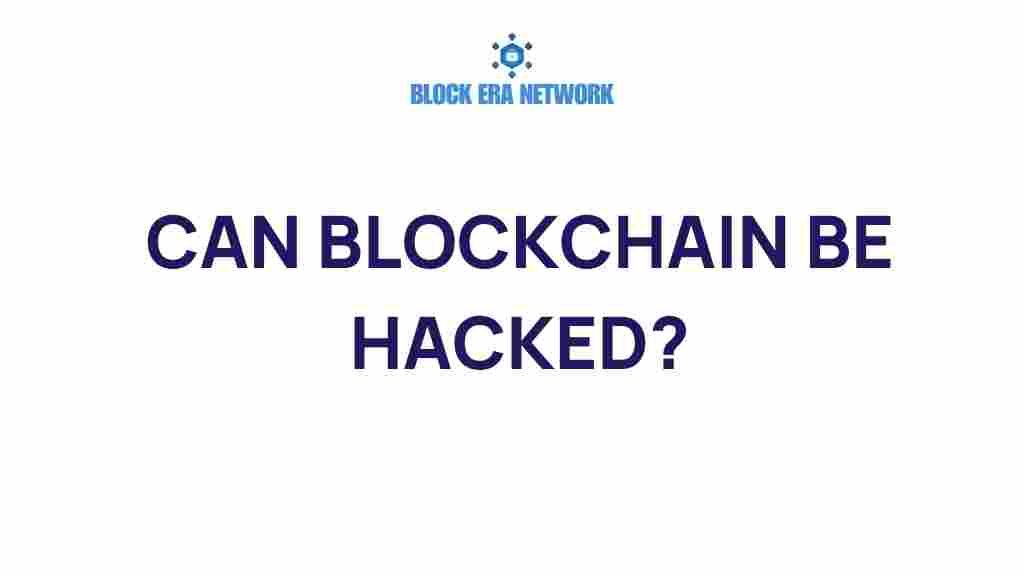What is Blockchain?
At its core, blockchain is a decentralized digital ledger that records transactions across multiple systems. Each transaction is added as a “block,” which is then linked to the previous block in chronological order, forming a chain. This decentralized structure ensures that no single entity has complete control over the ledger.
Blockchain technology is widely praised for its transparency, immutability, and security. However, with its growing adoption in industries like finance, healthcare, and logistics, concerns about its vulnerability to hacking have emerged. Can blockchain truly be hacked, or is it as secure as its advocates claim?
Can Blockchain Be Hacked?
The question, “Can blockchain be hacked?” often stems from misunderstandings about how this technology operates. While blockchain systems are renowned for their robust security features, no technology is entirely immune to risks. Understanding these risks requires a deeper dive into the structure and functioning of blockchains.
How Blockchain Security Works
Blockchain security relies on several key principles:
- Decentralization: Unlike traditional databases, blockchain stores data across a network of nodes, making it nearly impossible for hackers to alter the entire chain.
- Cryptography: Each block in the chain is secured using cryptographic hashes, which act as unique digital signatures.
- Consensus Mechanisms: Blockchain networks use algorithms like Proof of Work (PoW) or Proof of Stake (PoS) to validate transactions, preventing unauthorized modifications.
These features make hacking a blockchain extremely difficult, but certain vulnerabilities still exist, especially in the implementation of blockchain systems.
Common Vulnerabilities in Blockchain Systems
While the blockchain itself is highly secure, associated components can be potential weak points:
- Smart Contract Exploits: Smart contracts are self-executing programs on the blockchain. If poorly coded, they can be exploited by attackers.
- 51% Attacks: In this scenario, if a malicious actor gains control of more than 50% of a blockchain network’s computing power, they could potentially alter the chain.
- Private Key Theft: Blockchain relies on cryptographic keys for access. Losing your private key means losing access to your funds or data.
- Third-party Applications: Vulnerabilities in wallets, exchanges, or other applications can expose users to risks.
Real-life Examples of Blockchain Hacking
Despite blockchain’s security, there have been instances of successful attacks:
- The DAO Hack (2016): An exploit in Ethereum’s smart contract code led to the theft of $60 million worth of Ether.
- Bitcoin Gold 51% Attack (2018): Attackers gained control of the Bitcoin Gold network and double-spent transactions.
- Mt. Gox Exchange Hack (2014): A vulnerability in the exchange’s security led to the loss of 850,000 Bitcoins.
These cases underscore the importance of implementing robust security measures in blockchain systems and their associated applications.
Myths About Blockchain Security
Several myths surrounding blockchain security can lead to misconceptions. Let’s address some of the most common ones:
Myth 1: Blockchain is Completely Unhackable
While blockchain is incredibly secure, the statement that it’s completely unhackable is a myth. Weaknesses in adjacent systems, such as wallets or exchanges, are often exploited instead.
Myth 2: All Blockchains Are Equally Secure
Not all blockchains are created equal. Private blockchains, for instance, may lack the decentralization of public blockchains, making them more vulnerable to attacks.
Myth 3: Blockchain Eliminates All Fraud
Blockchain reduces certain types of fraud, such as double-spending. However, phishing attacks and social engineering tactics can still compromise users.
Safeguarding Blockchain Systems
To enhance blockchain security, consider the following measures:
Use Multi-Factor Authentication
Multi-factor authentication (MFA) adds an additional layer of protection for wallets and accounts, making it harder for attackers to gain unauthorized access.
Audit Smart Contracts
Regular audits of smart contracts can identify and fix vulnerabilities before attackers exploit them. Ensure your contracts are reviewed by trusted professionals.
Stay Updated
Cybersecurity threats evolve constantly. Keep software and security systems updated to address new vulnerabilities promptly.
Leverage Decentralized Security Measures
Use decentralized tools and technologies to enhance security further. For example, decentralized identity systems reduce reliance on centralized credentials.
Conclusion
Blockchain technology offers a revolutionary approach to digital security, but it’s not invincible. While the architecture of blockchain makes it incredibly resilient to attacks, vulnerabilities in related systems and applications can pose risks. By understanding these risks and implementing robust security measures, organizations and individuals can harness the full potential of blockchain without compromising safety.
To explore more about blockchain technology and its applications, check out our comprehensive guide to blockchain. Additionally, for insights from industry leaders, visit the CoinDesk website.
This article is in the category and created by Block Era Network Team

2 thoughts on “Can Blockchain Be Hacked? Unraveling the Myths and Realities”